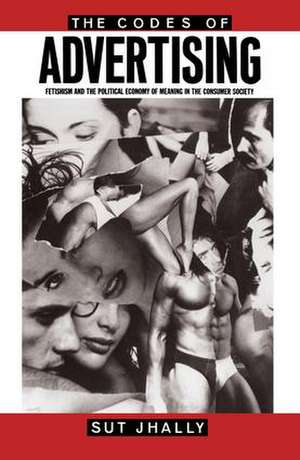The Codes of Advertising: Fetishism and the Political Economy of Meaning in the Consumer Society
Autor Sut Jhallyen Limba Engleză Hardback – 29 iul 2016
| Toate formatele și edițiile | Preț | Express |
|---|---|---|
| Paperback (1) | 344.75 lei 6-8 săpt. | |
| Taylor & Francis – 12 dec 1990 | 344.75 lei 6-8 săpt. | |
| Hardback (1) | 1000.27 lei 6-8 săpt. | |
| Taylor & Francis – 29 iul 2016 | 1000.27 lei 6-8 săpt. |
Preț: 1000.27 lei
Preț vechi: 1219.84 lei
-18% Nou
Puncte Express: 1500
Preț estimativ în valută:
191.39€ • 199.85$ • 158.05£
191.39€ • 199.85$ • 158.05£
Carte tipărită la comandă
Livrare economică 15-29 aprilie
Preluare comenzi: 021 569.72.76
Specificații
ISBN-13: 9781138145276
ISBN-10: 1138145270
Pagini: 240
Dimensiuni: 156 x 234 x 14 mm
Greutate: 0.45 kg
Ediția:1
Editura: Taylor & Francis
Colecția Routledge
Locul publicării:Oxford, United Kingdom
ISBN-10: 1138145270
Pagini: 240
Dimensiuni: 156 x 234 x 14 mm
Greutate: 0.45 kg
Ediția:1
Editura: Taylor & Francis
Colecția Routledge
Locul publicării:Oxford, United Kingdom
Cuprins
1. Introduction: Fundamentals and Starting Points 2. The Fetishism of Commodities 3. The Valorisation of Consciousness 4. The Codes of the Audience 5. Advertising Codes and Fetishism 6. Conclusion: Advertising, Religion and the Mediation of Meaning
Notă biografică
Sut Jhally teaches at the University of Massachusetts at Amherst.
Recenzii
"presents a detailed analysis of the specific political economy of the commercial, examining the way that, during advertising time on television, meaning is not only being generated in the relation between people and commercial messages, but is framed by the valorization of that watching activity." -- Journal of Economic Literature
Descriere
This book examines the commercial speech of advertising as a cultural phenomenon whose social significance far exceeds its economic influence. Jhally argues that by selling viewing time to advertisers, television converts audiences into laborers who "work" for the media in the same way that workers do in a factory. By watching commercial messages on TV, viewers actively create symbolic meaning, but also generate profit for the media in return for the wage of entertainment. (First published in 1991.)











